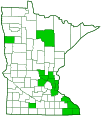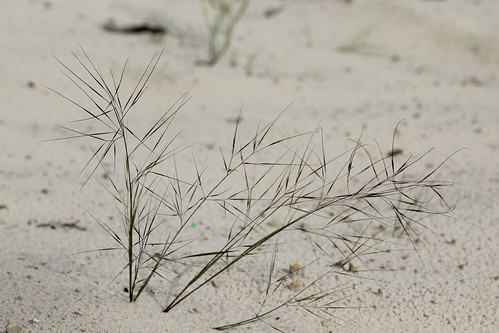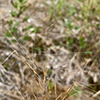seaside three-awn
(Aristida tuberculosa)
Conservation • Description • Habitat • Ecology • Use • Distribution • Taxonomy
Conservation Status |
|
|||||||
| IUCN Red List | not listed |
|||||||
| NatureServe | N4 - Apparently Secure S2 - Imperiled |
|||||||
| Minnesota | Threatened |
|||||||
Description |
||
Seaside three-awn is a small, annual, tufted, warm season grass. It occurs in the United States from New Hampshire to northern Florida, west to Minnesota and Louisiana. It is rare in eastern Minnesota, where it reaches the western extent of its range. It is found in prairies and savannas, on dunes, beaches, and roadsides, and in disturbed areas. It grows under full sun in deep, dry, sandy soil, sometimes in almost pure sand. It is declining due to habitat loss from agriculture, residential development, and urbanization. There is estimated to be between 81 and 300 surviving populations. It is listed as a threatened species in Minnesota due to habitat loss. Seaside three-awn has a fibrous root system. It does not form underground horizontal stems (rhizomes). The stems may be erect, curving up from the base (ascending), or reclining on the ground with the tip ascending (decumbent). They can be from 10″ to 60″ (25 to 150 mm) long, but in Minnesota they average just 12″ (30 cm) long. There are many lateral branches rising from the lower part of the base. The swellings where the leaves and lateral branches attach to the stem (nodes), and the space between the nodes, are both hairless. The leaves are borne along the stem, not at the base. The base of the leaf that wraps around the stem (sheath) is open. It may be hairless or be covered with soft hairs. The sheaths are usually slightly shorter than the space between the nodes. The collar often has a line of tangled hairs. The ligule is tiny, about 1⁄64″ (0.5 mm) in length. It consists of a fringe of short hairs. The leaf blade is light green, linear, 3″ to 10″ (8 to 25 cm) long, and 1⁄16″ to ⅛″ (2 to 4 mm) wide. It may be flat, or the margins may loosely curl inward toward the midvein on the upper side. The underside is hairless and smooth. The upper side is slightly rough to the touch. The inflorescence is a loose, open, sparingly branched cluster (panicle) at the end of the culm. The panicle is 4″ to 8″ (10 to 20 cm) long, and 1 3⁄16″ to 4″ (3 to 10 cm) wide. The primary branches are stiff and ascending. There are 1 to 4 spikelets on each branch, and there is a swelling of the branch at the base of each spikelet. Each spikelet has a single flower, a pair of sterile glumes, a single fertile lemma, and 3 anthers. The glumes are thin, yellowish brown and ¾″ to 1 3⁄16″ (20 to 30 mm) long. They have a single vein and a 3⁄16″ to ⅜″ (5 to 10 mm) long, bristle-like extension (awn) at the tip. The upper glume is slightly longer than the lower glume. The lemma is ⅜″ to 9⁄16″ (10 to 14 mm) long, not including the ⅛″ (3 to 4 mm) long thickened basal extension (callus). At maturity the lemma is dark, mottled, rolled up longitudinally, and spindle shaped. It has three veins and is usually hairless, sometimes sparsely hairy. There are 3 nearly equally sized awns at the tip. The awns are twisted at the base into a 5⁄16″ to ⅝″ (8 to 15 mm) long column, then strongly curved at the base of the 1 3⁄16″ to 1 9⁄16″ (30 to 40 mm) long tip. The long tips are strongly spreading or slightly bent downward. At maturity, they are spread at an angle of about 120° to each other. |
||
Height |
||
10″ to 60″ (25 to 150 mm) |
||
Similar Species |
||
The distinctive twisted column at the base of the awns distinguishes seaside three-awn from all other Aristida species. |
||
Habitat |
||
Dry. Full sun. Prairies and savannas, dunes, beaches, roadsides, and disturbed areas. Deep sandy soil. |
||
Ecology |
||
Flowering |
||
July |
||
Pests and Diseases |
||
|
||
Use |
||
|
||
Distribution |
||||
|
Sources |
|||
| 11/19/2023 | ||||
Nativity |
||||
Native |
||||
Occurrence |
||||
Rare |
||||
Taxonomy |
|||
| Kingdom | Plantae (Plants) | ||
| Division | Tracheophyta (Vascular Plants) | ||
| Subdivision | Spermatophytina (Seed Plants) | ||
| Class | Liliopsida (Monocots) | ||
Order |
Poales (grasses, sedges, cattails, and allies) | ||
Family |
Poaceae (grasses) | ||
Subfamily |
Aristidoideae (threeawns and wiregrasses) | ||
Tribe |
Aristideae | ||
Genus |
Aristida (wiregrass) | ||
Subordinate Taxa |
|||
|
|||
Synonyms |
|||
Chaetaria tuberculosa |
|||
Common Names |
|||
beach needlegrass beach three-awned grass seabeach needlegrass seaside threeawn seaside three-awn |
|||
Glossary
Ascending
Growing upward at an angle or curving upward from the base.
Awn
A stiff, bristle-like appendage at the tip of the glume, lemma, or palea of grass florets.
Collar
In grasses: The area on the back of a grass leaf at the junction of the sheath and the blade. On moths: the upperside of the prothorax.
Decumbent
Reclining on the ground but with the tip ascending.
Glume
A chaffy, empty, sterile bract at the base of a grass spikelet. Glumes usually occur in pairs, but occasionally only one is present.
Lemma
The outer, lowermost of the pair of bracts at the base of the grass floret; it ensheathes the palea.
Ligule
In grasses and sedges, an outgrowth on the leaf at the junction of the blade and the sheath, usually membranous, sometimes no more than a fringe of hairs. In flowering plants, the ligule is the flat, strap-shaped, petal-like portion of the corolla of a ray floret.
Linear
Long, straight, and narrow, with more or less parallel sides, like a blade of grass.
Node
The small swelling of the stem from which one or more leaves, branches, or buds originate.
Panicle
A pyramidal inflorescence with a main stem and branches. Flowers on the lower, longer branches mature earlier than those on the shorter, upper ones.
Rhizome
A horizontal, usually underground stem. It serves as a reproductive structure, producing roots below and shoots above at the nodes.
Sheath
The lower part of the leaf that surrounds the stem.
Spikelet
In flowering plants, a small spike. In grasses and sedges, the basic unit of inflorescence. In grasses, composed of usually two glumes and one or more florets. In sedges, a single flower and its single associated scale.
Visitor Photos |
|||||
Share your photo of this plant. |
|||||
| This button not working for you? Simply email us at info@MinnesotaSeasons.com. Attach one or more photos and, if you like, a caption. |
|||||
Jordan Wilson |
|||||
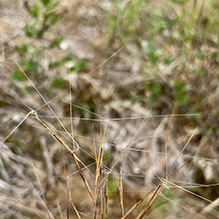 |
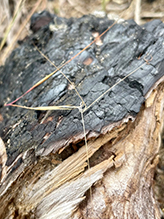 |
||||
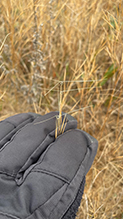 |
|||||
| This is the habitat of A. tuberculosa. It can be found in the dry barrens Oak savanna portions of the (Uncas Dunes) SNA accessible from the entrance located in the Ann Lake Campground. | 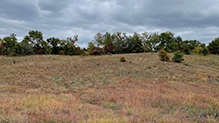 |
||||
MinnesotaSeasons.com Photos |
|||||
|
|||||

Visitor Videos |
|||
Share your video of this plant. |
|||
| This button not working for you? Simply email us at info@MinnesotaSeasons.com. Attach a video, a YouTube link, or a cloud storage link. |
|||
Other Videos |
|||

Visitor Sightings |
|||||
Report a sighting of this plant. |
|||||
| This button not working for you? Simply email us at info@MinnesotaSeasons.com. Be sure to include a location. |
|||||
| Jordan Wilson 11/10/2023 |
Location: Kellogg Weaver Dunes SNA, Weaver Dunes Unit |
||||
| Jordan Wilson 9/23/2023 |
Location: Uncas Dunes SNA, North Unit |
||||
MinnesotaSeasons.com Sightings |
|||||
|
|||||

Created: 11/19/2023
Last Updated:
